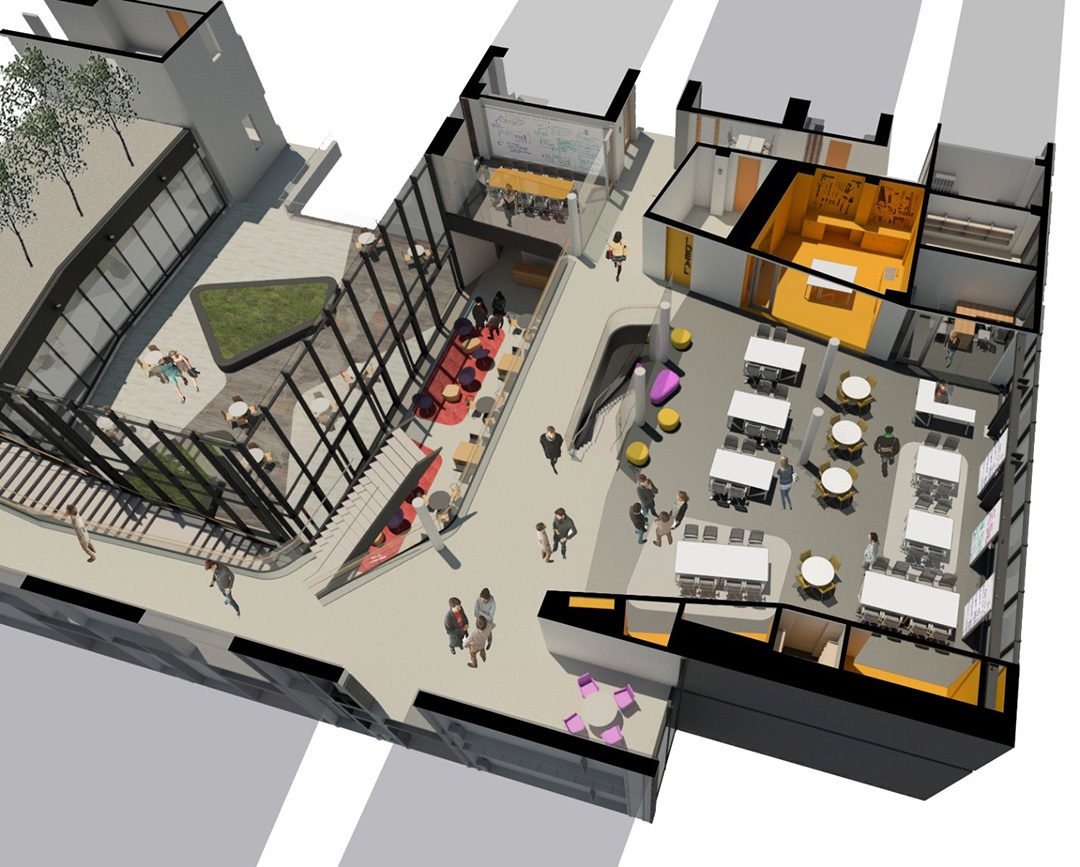Even though the term makerspace is fairly new, our firm has been involved in the design of facilities over the past 20 years which required flexible work space for experimentation, collaboration and prototyping a range of projects. For example, a high bay work lab was incorporated into the first Virginia Commonwealth University School of Engineering building, constructed in the mid 1990’s, including a work bench area and open space with an overhead crane to provide a build area for student projects like solar cars. In the early 2000’s a rapid prototyping lab with an early generation of 3D printers was included in the Giancarlo Lab at Brown University’s School of Engineering. Subsequent projects, mainly for engineering schools and other academic institutions, included computer modeling and build space with increasing technological capabilities.
On the Boards: Current Makerspaces
At Lafayette College, we designed a science center currently under construction which will feature a makerspace in the public lobby area of the building. As part of IDEAL, an innovation and entrepreneurship program, the space will foster activities geared toward design thinking, product/idea prototyping,financial analysis and marketing skills necessary for taking an idea from conception to development.

The open multi-use flexible maker space fosters collaboration and entrepreneurship
The space is a flexible open work area supported by adjoining enclosed tool rooms and small computational and meeting rooms. The specifics of use and projects to be conducted will be determined as occupancy comes closer.
Institute for Integrated Science and Society (*client name confidential)
At another new interdisciplinary science center currently in early design, three makerspaces are being planned. Though there has been strong interest in entrepreneurship on campus, most of the efforts so far have been student initiatives in improvised spaces. With this opportunity to create three new spaces to expand and better manage these initiatives, we have had a lot of discussion with the college’s working group on the characteristics and functions that each space will have. One of them will be a Center for Entrepreneurship, where students take their business from idea to launch. The second will be the University Makerspace, which will open to all students and faculty from any discipline. Basic tools will be provided, making them easily accessible to users of all experience levels. The third will be a Design and Prototype Lab, which will house advanced larger scale tools such as a laser cutter or fume hood. An area of this space will be secured, available to those who complete the required training. During our planning process, we developed a matrix that categorizes the look and feel, uses, storage needs and other design criteria, which was helpful to both the design team and users in differentiating the activities expected at each space.
Locating these maker spaces within the building also requires many considerations. We asked questions like, should they be spread out to promote visibility and synergies with adjacent teaching spaces? Or, should they be concentrated for easier management and to avoid duplicating resources?
We decided to locate the Center for Entrepreneurship and the University Makerspace on the most public floor of the building, next to general purpose classrooms. Together they can activate the floor and attract students from all majors to collaborate on wide range of projects. The Design and Prototype Lab will be located on an upper floor. This places it adjacent to engineering teaching labs and one flight below two levels of research labs. The Design and Prototype Lab it will cater to more advanced specialized needs.

Looking to the Future
As we look to the future, it is clear that makerspaces in academia are not only here to stay, but will become a vital part of the curriculum across multiple disciplines. No longer exclusively a space associated with engineering programs, many undergraduate institutions are embracing collaborative programs that will bridge arts and sciences as well as conceptualization and making. The hands on approach parallels the emphasis on problem-based learning that has become a major part of the pedagogy in higher education institutions and K-12 schools. Eventually, makerspaces, with their emphasis on collaboration and community, may become the new libraries or heart spaces of campuses. Already, this is manifested in programs where libraries lend tools and provide project work space along with serving as information resource centers. Makerspaces are both the present and the future.


